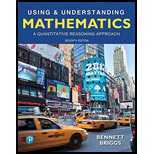
Concept explainers
Housing Price Index. Realtors use an index to compare housing prices in major cities. The housing price index values for several cities are given in the table below. Use the following formula to answer the questions. 
 index of other town
index of other town
| City | Index | City | Index |
| Atlanta | 100 | Las Vegas | 115 |
| Boston | 146 | Los Angeles | 190 |
| Chicago | 105 | Miami | 161 |
| Dallas | 121 | Phoenix | 122 |
| Denver | 136 | San Francisco | 172 |
27. For a house valued at $400,000 in Phoenix, find the price of a comparable house in Miami.
Want to see the full answer?
Check out a sample textbook solution
Chapter 3 Solutions
Using & Understanding Mathematics: A Quantitative Reasoning Approach (7th Edition)
- 1. One of the partial fractions for 2 2 4x²+x-9 x3+2x²-3x a) x3 b) x11 c) x² d) z x-1 2. Identify the improper integral. 1 x 2 x dx a) 3x dx b) f² 3x dx 0 3-2x 0 3-2x x is c) √2^: 4 √232x dx d) fo² 3x dx 1 1 0 3-2x B. So eax dx converges to if : a) O if a0 c) - 1½ ifa 0arrow_forwardComplete the square and find the indefinite integral. (Remember to use absolute values where appropriate. Use C for the constant of integration.) dx x²-12x+27arrow_forwardComplete the table. Enter DNE if a quantity doesn't exist or NEI if not enough information is given. f(c) limx-->c- f(x) limx-->c+ f(x) limx -->c f(x) continuity at x=c 2 4arrow_forward
- Find the indefinite integral. (Use C for the constant of integration.) 9x arcsin(x) dxarrow_forwardFind the indefinite integral using the substitution x = 5 sin(e). (Use C for the constant of integration.) 1 dx (25-x²)3/2arrow_forwardFind the indefinite integral using the substitution x = 7 sec(0). (Use C for the constant of integration.) √ ׳ √x² - 49 dxarrow_forward
- Use the Cauchy Riemann equations (polar form version). Also, describe what happens at the branch cut.arrow_forwardb. i. Show that the following matrix is orthogonal. A = ドードー ii Find the inverse of matrix A. Show all working in an organized/orderly manner. 2 3 -619 A = 42 3 1 5 B-1127) a. Given D = , decode the following message: 32, 24, 42, 28, 24, 40, 50, 60, 132, 96, 12, 24arrow_forward2 Graph of h 6. The graph of the function h is given in the xy-plane. Which of the following statements is correct? , the graph of h is increasing at an increasing rate. (A) For (B) For (C) For 苏|4 K|4 π π , the graph of h is increasing at a decreasing rate. 2 0 and b>1 (B) a>0 and 01 (D) a<0 and 0arrow_forwardQUESTION 4 Peter says that the following expressions can be simplified into one trigonometric ratio without the use of a calculator. Prove that Peter is correct by simplifying the following expressions into one trigonometric ratio: 4.1 sin 43° + sin 17º (5)arrow_forward3. Consider the sequences of functions fn: [-T, π] → R, sin(n²x) n(2) n (i) Find a function f : [-T, π] R such that fnf pointwise as n∞. Further, show that f uniformly on [-T,π] as n→ ∞. [20 Marks] (ii) Does the sequence of derivatives f(x) has a pointwise limit on [-7,π]? Justify your answer. [10 Marks]arrow_forwardAmong a student group 54% use Google Chrome, 20% Internet Explorer, 10% Firefox, 5% Mozilla, and the rest use Safari. What is the probability that you need to pick 7 students to find 2 students using Google Chrome? Report answer to 3 decimals.arrow_forwardarrow_back_iosSEE MORE QUESTIONSarrow_forward_ios
 Glencoe Algebra 1, Student Edition, 9780079039897...AlgebraISBN:9780079039897Author:CarterPublisher:McGraw Hill
Glencoe Algebra 1, Student Edition, 9780079039897...AlgebraISBN:9780079039897Author:CarterPublisher:McGraw Hill Algebra: Structure And Method, Book 1AlgebraISBN:9780395977224Author:Richard G. Brown, Mary P. Dolciani, Robert H. Sorgenfrey, William L. ColePublisher:McDougal Littell
Algebra: Structure And Method, Book 1AlgebraISBN:9780395977224Author:Richard G. Brown, Mary P. Dolciani, Robert H. Sorgenfrey, William L. ColePublisher:McDougal Littell Functions and Change: A Modeling Approach to Coll...AlgebraISBN:9781337111348Author:Bruce Crauder, Benny Evans, Alan NoellPublisher:Cengage Learning
Functions and Change: A Modeling Approach to Coll...AlgebraISBN:9781337111348Author:Bruce Crauder, Benny Evans, Alan NoellPublisher:Cengage Learning Big Ideas Math A Bridge To Success Algebra 1: Stu...AlgebraISBN:9781680331141Author:HOUGHTON MIFFLIN HARCOURTPublisher:Houghton Mifflin Harcourt
Big Ideas Math A Bridge To Success Algebra 1: Stu...AlgebraISBN:9781680331141Author:HOUGHTON MIFFLIN HARCOURTPublisher:Houghton Mifflin Harcourt Holt Mcdougal Larson Pre-algebra: Student Edition...AlgebraISBN:9780547587776Author:HOLT MCDOUGALPublisher:HOLT MCDOUGAL
Holt Mcdougal Larson Pre-algebra: Student Edition...AlgebraISBN:9780547587776Author:HOLT MCDOUGALPublisher:HOLT MCDOUGAL Elementary AlgebraAlgebraISBN:9780998625713Author:Lynn Marecek, MaryAnne Anthony-SmithPublisher:OpenStax - Rice University
Elementary AlgebraAlgebraISBN:9780998625713Author:Lynn Marecek, MaryAnne Anthony-SmithPublisher:OpenStax - Rice University





